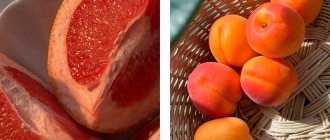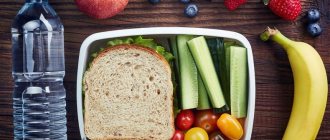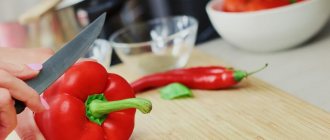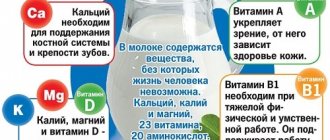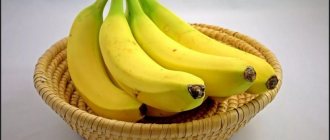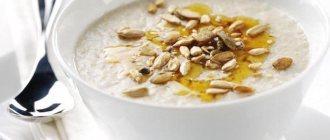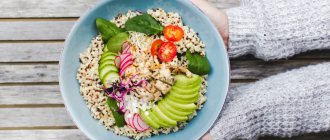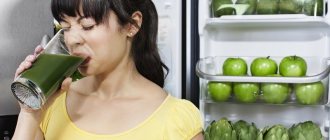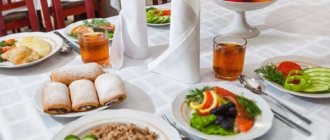Calorie concept
The concept of caloric content from Wikipedia
Caloric content Caloric content is the amount of energy that the human body receives after digesting food. Expressed in calories or less commonly in kJ per 100 g (100 ml). The indicator is also called energy value. This value must be indicated on the label of all food products, except those that do not have it at all (water, salt).
Calorie content is calculated based on the chemical composition. Every 1 g of proteins and carbohydrates releases 4 kcal during metabolism, and 1 g of fat releases 9 kcal. You don’t need to think that products that don’t contain dietary fat are automatically calorie-free.
Spirits and beer have a high energy value due to the fact that ethanol is a fuel, which provides 7 kcal per gram. Citric and other organic acids (lactic, tartaric) by their nature are neither proteins, nor fats, nor carbohydrates, but their calorie content is about 2 kcal per 1 g.
Fruits
Compared to vegetables, fruits contain little fiber but more carbohydrates. Below is a list of the lowest calorie fruits:
- Cherry plum - 27 kcal/100 g. This dietary product contains a large amount of vitamin E, C, calcium, pectin, organic acids, magnesium and iron. It is healthier in dried form.
- Cherry - 52 kcal/100 g. It contains malic acids, pectins, and dietary fiber. It is a good tonic, strengthens the immune system, improves the condition of the skin and hair.
- Grapefruit - 42 kcal/100 g. The fruit contains 34% of the daily requirement of vitamin C, as well as A, group B, D, calcium, potassium, magnesium and other elements. Reduces cholesterol, normalizes acidity, stabilizes blood sugar levels.
What foods are considered low-calorie
The division of food into categories is quite arbitrary.
- Low-calorie foods are considered to be those that provide no more than 100 kcal per 100 g. This group includes almost all fruits and vegetables, berries, and some low-fat dairy products.
- Medium-calorie products provide from 100 to 200 kcal per 100 g. These include many types of meat and fish, eggs, and dairy products.
- High calorie foods. This category contains the fattiest meats, vegetable oils and animal fats. This also includes food from McDonald's and other fast food, white sugar, chocolate and nuts. Their energy value is 400-900 kcal per 100 g.
To lose weight, preference should be given to low-calorie foods, and foods from groups 2 and 3 should be included in the diet in strictly dosed quantities. There are also foods with negative calories. The body spends as much energy on digesting them as it receives.
This group includes cucumbers, seaweed, celery, spinach, and grapefruit. They will help you lose weight faster, so you should include them in your menu more often.
Berries
One thing you need to know about berries: the more acidic they are, the lower the calorie content. In addition, dark-colored berries are also strong antioxidants. The lowest calorie ones include the following:
- Cranberry - 26 kcal/100 g. The berry strengthens the immune system due to its high content of vitamin C. Cranberry juice is useful for colds, as it is an antipyretic and anti-inflammatory agent.
- Grapes - 65 kcal/100 g. This berry is considered an excellent antioxidant and helps fight gastrointestinal problems. It contains vitamin C, K, B (1,6,2), manganese, iron, magnesium and other trace elements.
- Strawberry - 32 kcal/100 g. This berry contains 52% of the daily dose of vitamin C. It contains antioxidants and anti-aging flavonoids. Reduces the risk of cardiovascular diseases, improves skin condition.
What does caloric content depend on?
The energy value of food depends on its chemical composition. The more water and less BJU in a product, the less calorie it will be. Since lipids provide the most calories, fatty foods will be the heaviest.
The caloric content of the diet is also affected by:
- Size of dishes. The larger the portion, the more energy the body will receive from it. That is why one of the important steps in optimizing nutrition is rationing food by weight.
- Cooking method. When dried, the beneficial substances are concentrated by removing water. The nutritional value of dried fruits is always higher than that of fresh fruits. So from 100 g of grapes the body will receive only 70 kcal, and from 100 g of raisins already 300 kcal. When frying, the energy value always increases due to the addition of oil.
- Combination of products. If you combine heavy ingredients (fatty meat, fish) with lighter ingredients (vegetables) in one dish, the portion will be medium in calorie content.
The energy value of some products can be reduced by producing low-fat versions. This applies to dairy products (cottage cheese, yogurt, kefir). Another way to reduce calories is to replace sugar with synthetic sweeteners, which have no nutritional value.
Green tea
Photo by Pixabay
Nutritionists call green tea the most beneficial drink that can help burn fat. This drink must be drunk without sugar and milk, it can be hot or cold, it depends on the time of year. It is known that each tea cup of real green tea, drunk within one day, helps burn up to 60 kcal, and you can drink up to five of them per day. In addition, green tea has a beneficial effect on the functioning of the heart, blood vessels, and digestive tract organs, tones and is a “beauty drink.”
Are low-calorie foods always good for you?
Harmony is when all the calories that enter the body are consumed and there is no remainder. A person's need for energy depends on many factors. Here is their list:
- age and gender;
- weight;
- Kind of activity;
- health status;
- climatic living conditions.
Low-calorie foods are needed for those who are overweight and want to lose weight. During heavy physical work, active sports training, during recovery after surgery and growth, the body needs a lot of calories.
A large amount of energy is spent on heating the body in winter, which is especially important for harsh regions. The need for kcal increases by 15-25% during pregnancy and breastfeeding.
The physiological norm for men is considered to be 2100-4200 kcal per day, for women it is 1800-3050 kcal. Lack of energy will cause a person to be lethargic and unable to concentrate.
For a child’s body, this is fraught with delays in mental and physical development. If a person is malnourished, then he does not receive vital elements: amino acids, unsaturated fats, glucose, vitamins and minerals. This leads to the development of diseases. Therefore, any restrictions must be reasonable.
Miracle kelp
Who hasn't tried this algae? There are probably none! But it should be said that not everyone appreciates its taste. It may not be as tasty as we would like, but when synergized with other vegetables in soups, side dishes and other dishes, it is delicious! And if we also remember how useful kelp is, then this algae has no equal in the entire product range.
The Japanese, for example, in order to preserve all the properties of seaweed, eat it in its pure raw form, seasoned with rice vinegar and sesame seeds. You can blanch the product for a few seconds in salted water, then its taste will not be so strong.
Alternatively, try chopping up some kelp stalks and cooking them with legumes. This will make the latter more tender and allow them to be more easily absorbed by the body, giving them a unique aroma.
Low calorie foods
To lose weight, you usually reduce your caloric intake per day to 1500 kcal for the duration of the diet. If you divide this into 5 meals, you get about 300 kcal at a time.
There is no need to strive to eat only 100 kcal, this is too little for normal life. Only snacks can be this meager if you have a normal breakfast, lunch and dinner. Choose low-calorie foods, but stay within the recommended daily intake for your weight and health.
What to eat for breakfast and tea
From dairy products, cottage cheese is useful in the morning: 200 g of low-fat product gives approximately 150 kcal, it can be supplemented with fruit. Oatmeal is another good solution: 50 g of cereal will add no more than 180 kcal, and boiling water (water) for steaming will add zero calories.
Advice
Carbohydrate meals are best eaten in the morning. A small portion of durum porridge or pasta is also allowed.
All sweets are highly nutritious. You can have dark chocolate with tea, and then only 2 slices from the entire bar. Or you will have to choose dietary products with sweeteners in the store.
For a snack
The best option is one fruit (banana, pear, apple) or a salad of fresh vegetables rich in fiber. You can eat nuts, but not more than 30-40 g at a time. A glass of any berries is also suitable for a snack. They are rich in vitamins and antioxidants.
For dinner
A good choice is a glass of fermented milk drink (kefir, yogurt, fermented baked milk). This portion, depending on the chosen fat content, has 80-120 kcal. You can add greens to them.
Nutritionists advise drinking fermented milk drinks even on a diet, as they help cleanse the intestines. A good dinner is 2 boiled eggs or an omelet with herbs, baked lean fish. These high-protein foods can be eaten in the evening without harming your figure.
Citrus fruits: grapefruit, lemon, orange, tangerine, lime
Photo by Pixabay
These fruits are recognized masters of burning the hated extra pounds. It is known that eating grapefruit daily for two weeks will reduce weight by approximately two kilograms. Citrus fruits contain a lot of fiber and vitamins - especially vitamin C. Citrus fruits have mild diuretic and laxative properties. The calorie content of each citrus fruit does not exceed 40 kcal.
TOP 7 Hearty foods with low calorie content
To ensure a feeling of fullness, food must be of sufficient volume and not digest too quickly, and include nutritional components. Here is a list of low-calorie weight loss foods that can satisfy your hunger:
- Boiled egg. One weighs about 50 g, so it will bring about 70 kcal. It can be supplemented with a slice of cheese or bread, cucumber or other vegetable. 2 pieces will make a complete hearty lunch.
- Baked potato. It is quite high in calories: 160 kcal in one root vegetable, but it is filling. It’s convenient to take to work or on the road, and goes well with raw vegetables.
- Fish. Due to its significant protein content, it satisfies hunger well. A serving of 200 g of low-fat fish and lunch or dinner for 150 kcal is ready.
- Meat. To saturate, 100 g is enough. The main thing is that it is boiled or stewed, but not fried.
- Cottage cheese and fermented milk drinks. A small portion of 100-150 g, provided it has low fat content, not only gives strength, but also provides the body with proteins, calcium, and beneficial microorganisms.
- Apples. One sweet thing contains about 50 kcal. As a full meal this is not enough, but as a snack it is a good option.
- Avocado. Due to the significant amount of fat, the fruit is very nutritious. Its 100 g contains up to 220 kcal.
The lowest calorie foods (up to 50 kcal per 100 g) are not nutritious. You don’t need to think that 1 cucumber will provide you with a feeling of fullness for several hours.
Watermelon
Photo by Pixabay
The vast majority of people love watermelon. And, of course, many have heard about its ability to cleanse the kidneys and flush the intestines. Watermelon quenches thirst well in the heat; it also gives a feeling of quick satiety, which, given its low calorie content - only 20 kcal per slice, is very useful in diets for weight loss. Watermelon has many vitamins and microelements, as well as complex sugars and fiber.
Table: low-calorie foods with calories
All data in this list is given taking into account the Chemical Composition of Food Products edited by I.M. Skurikhina.
- Vegetables. On a diet, you can eat a lot of them, except potatoes. If you make a multi-colored mix of them, you can even add a little nuts or butter.
Vegetable Energy value, kcal per 100 g Lettuce leaves 14 Cucumber 15 Fresh mushrooms 20-25 Eggplant 24 Zucchini 27 bell pepper 27 White and red cabbage 28-30 - Fruits and berries.
Due to sugars, their value is slightly higher than that of vegetables. You just need to be careful with dried fruits, especially dates. And most fruits and berries have a nutritional value of no more than 50 kcal. The same indicators apply to juices.Fruits and berries Energy value, kcal per 100 g Pear 42 Peach 44 Plum 43 Apples 46 Orange 38 Cherry 49 Cherries 52 Grape 69 Strawberry 40 Raspberries 41 - Cereals, grains and legumes. These affordable products cannot be called low-calorie; all of them have a value of 300-350 kcal. When losing weight, you should eat these products little by little.
Product Energy value, kcal per 100 g Wheat flour 327-329 Rye flour 321-326 Beans 309 Peas 303 Buckwheat 329 Rice 323 Hercules 355 Pasta 330-335 Bread 200-220 - Dairy products. If you take low-fat options, you can eat milk, kefir, yogurt and cottage cheese. Hard cheeses have a nutritional value of about 350-400 kcal. Therefore, only a thin slice is allowed on the diet.
Product Energy value, kcal per 100g Milk 2.5% fat 58 Skim milk 31 Sour cream 10% fat 116 Low-fat cottage cheese 86 Kefir 3.2% fat 59 Low-fat kefir 30 Yogurt 1.5% 51 - Fish and seafood. You need to choose low-fat varieties. Cheap fish include hake and pollock.
Sea kale is very healthy: minimal calories and a lot of iodine. All canned fish have a higher calorie content due to the addition of oil.Fish and seafood Energy value, kcal per 100g Sea kale 5 Pink salmon 147 Catfish 110 Flounder 86-90 crucian carp 86 Carp 96 Pollock 70 Zander 83 Hake 86 Pike 82 Squid 75 Shrimps 80 - Meat, poultry, eggs. The most dietary meats are veal and poultry (chicken, turkey). Offal products have similar indicators.
Meat Energy value, kcal per 100g Veal 90 Beef liver 98 Beef kidneys 66 Language 163 Chicken 130 Turkey 134 Eggs 157 - Nuts. Kernels are a very heavy food; 100 g of them provide 500-700 kcal. Therefore, you need to eat them literally a few pieces at a time, no more.
Nuts Energy value, kcal per 100g Peanut 550 Cashew 630 Sweet almond 650 Hazelnut 700 Sunflower seeds 578 Sesame 523
Vegetable oil is not low-calorie, since it is almost 100% fat. Its energy value is 880 kcal. Therefore, you should not add more than 1 tbsp at a time. As for creamy, there are slight variations.
There are lower-fat varieties of butter (up to 70%), high-fat (82.5%) and even ghee with 99.9% lipids, their calorie content is 600-800 kcal.
Recipes for low-calorie dishes for weight loss for every day
You can prepare many simple and tasty dishes from low-calorie foods:
- Meat products in half with vegetables. Chicken and zucchini cutlets or casserole are super easy to make and don't taste dry at all. The bird can be baked with mushrooms.
- For breakfast, there are many recipes for lazy oatmeal in a jar. It is convenient to take it to work.
- For lunch, a great option is puree soup with vegetable broth or with chicken. In the summer, okroshka and cold beetroot borscht will come in handy.
- Stuffed vegetables with soft cheese and herbs, and a lavash roll without mayonnaise are ideal as an appetizer
- Desserts include smoothies, fruit ice cream, and berry jelly.
- By adding oatmeal, low-fat cottage cheese without flour makes delicious cheesecakes and casseroles .
And how many recipes for low-calorie salads exist! A complete description of the preparation of dietary dishes can be found in the recipes section.
The energy value of food is crucial for normal weight. Low-calorie foods are the best helpers in the fight against extra pounds. Among them there is a lot of tasty and satisfying food. And with the help of apps on your smartphone, counting calories is easy.
Vegetables that help you lose weight
Photo by Pexels
Everyone knows these vegetables with minus calorie content - zucchini, cucumbers, tomatoes, asparagus, peppers, beets, spinach, carrots, turnips, eggplants, pumpkin. I would especially like to mention onions and garlic - these products help speed up metabolic processes, and also cleanse the kidneys and intestines of a person, and serve as natural antibacterial agents.
